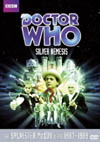DVD Extras include:
VHS Extras include:
Once more we see the Doctor having deviously set-up a complicated trap for his enemies, but we also get to see how he remembers it and realizes that now is the time to see exactly who he has caught in it, and how to go about tidying up all the related affairs. Nice. Though the TARDIS is once more treated as just a background detail of the Doctor's existence, it's a particularly busy one in this adventure, as we see far more satisfying movement of the vehicle in these three episodes than we usually would in an entire season of Doctor Who. Only after the materialization effect has been done many times do they start skimping on it here and there, and at that stage, one doesn't mind so much. Sadly, the interior does not feature at all - with its most important scenes being rewritten for outdoor gatherings around Ace's ghettoblaster. Not very nostalgic or Anniversary-like in my book. When the characters finally do come together, we get bizarre flip-flops between all-out battles to the death, and friendly discussion and truce, and trying to follow the logic behind all these changes of tactics is a struggle. Sometimes it works, sometimes it's ridiculous as written, sometimes it needs far more careful blocking of character movements and cameras than the director and crew could find time for. The bottom line may well be that these characters are all too self-centered and violently antagonistic towards each other to be able to sustain a satisfying drama when put together. Even the one-dimensional "you can't shoot me because I'm holding the Tarranium" gag, initiated in "The Dalek Masterplan" (story no. 21) and copied half a dozen times in later stories, might offer an improvement in clarity and believability over the much more complicated face-to-face tactics attempted here, even if it still isn't the greatest idea. The Cybermen are the most famous draw amongst the story's villains, and with their entrance held back for the first cliffhanger, and with this being a short 3-parter, that leaves them with only two episodes of screen time, which they have to share with the other villains. As a result, this isn't one of their greatest showings, probably competing with "The Wheel in Space" (story no. 43) for the honour of their lightest, least effective story. However, we find out that they have had much off-screen influence in the first episode anyway, and they do make a spectacular entrance. Ideas like cyber-controlled humans are thrown casually into the mix here, without any hint of the atmosphere that such ideas should be at the center of, like we had in "The Moonbase" (story no. 33). However, watch for some VERY exciting, energetic, atmospheric Ace vs Cybermen beats in the last episode - which I think show where talented director Chris Clough's efforts went before the production ran out of time. The South American neo-nazis led by Anton Diffring's character are really never interesting at any point. They're not really a great idea as written, and none of them receive very inspired performances from the actors. Lady Peinforte and her sidekick Richard drip with the atmosphere of a British medieval theatre production, which I suppose is the "romantically correct" modern interpretation of life in the 1600's. There's quite a bit of rich "fish out of water" drama sprinkled throughout the story for these two, alternating between comedic and dark creepy moments, but sadly this is often at odds with the plot, not finding a place where it complements action and motivation. Fiona Walker and Gerard Murphy milk the roles for as much of a sense of classical drama as they can, until these two easily become the most compelling guest stars that the story has. Still, the Peinforte character goes a bit too far when reveling in an interpretation of herself as evil - perhaps the character would remain more interesting had lines with such references been amongst those on the cutting room floor. It's also hard to know how to take the Peinforte character seriously, and with her the story's tactics, when she starts out by apparently using magic to travel through time. At least magic seems to have nothing to do with the rest of her time on screen, but she could probably have worked much better had her backstory revealed more human motivations, and more believable time-travel details. At least the arrow she carries with her ensures that there's no chance of the statue becoming complete between 1638 and 1988. This pair's hitchhiking encounter with the woman from southern U.S.A. produces interesting scenes, but they feel out of place at that late point in the narrative, slowing down the final movements of story. By contrast, they really needed this kind of interaction when they first landed in this time zone loudly screaming, yet get inexplicably ignored by a whole café full of bystanders.
"Silver Nemesis" probably would have worked better with some studio work - the scenes in Lady Peinforte's crypt in 1988 probably would have been more spacious and received better camera blocking (in fact, ditto for Peinforte's 1638 study), the Cybermen would have been more clearly audible whenever they're inside buildings, and scenes inside the Cyber spaceships and the Doctor's TARDIS would have helped keep the science fiction background of these characters more pronounced and powerful.
Then I saw the amazing work Chapman did for "Remembrance of the Daleks" (story no. 152), and I felt sure that the cyber weapons would finally be truly awesome and cool. Finally, "Silver Nemesis" came along.... and revealed that Chapman had added nothing to the picture at all. What the hell?!?! I don't know why so many British people working in science-fiction settle so easily for spark-charges going off all by themselves. It's definitely sillier that way. The effects Chapman does work on are not always so great either, particularly the kind of time-storm animation that surrounds Peinforte and Richard early on, or later the statue as it floats about. Some of the work with the Cybership and the meteor looks good, but other bits are far too 2-dimensional, particularly the Cyber fleet near the end. Thankfully, the Doctor and Ace are a highly enjoyable and entertaining pair as usual, providing a great deal of the story's draw. Sophie Aldred seems as fluid in the role as she was in "The Happiness Patrol", although the writing is largely much better for her here. Still, one scene in particular sticks out sorely, where Ace stops everything to tell the Doctor that she's really scared, and then promptly shrugs it all off to go tackle the devious trap-setting of the day. This doesn't seem to actually do anything for plot, or character arcs, nor does it fit Ace's character, particularly as she has no idea she'll be ending up in a mini cyber-war of her own soon. Although many of the ideas for this story feel unique at first, the closer we get to the end, the more everything seems to copy "Remembrance of the Daleks" far too closely, until the ending leaves you feeling like you've seen the whole thing done better before. Even some of the more unique bits have their equivalent in deleted scenes from "Remembrance". But there is a lot to enjoy here, and even the repeated bits work well to cement into place McCoy's take on the long-running character. This is a fun story.
International Titles:Deutsch: "Das Vermächtnis der Nemesis"Magyar: "Ezüst végzet"Français: (Nemesis argentée)Русский: "Серебряная Немезида"Once again, it is the Germans who dare to be different, this time coming up with "The Legacy of Nemesis".
This story has become available on DVD and VHS video. Click on the Amazon symbol for the location nearest you for pricing and availability:
Comments on this article are welcome. You may contact the author from this page:
|








